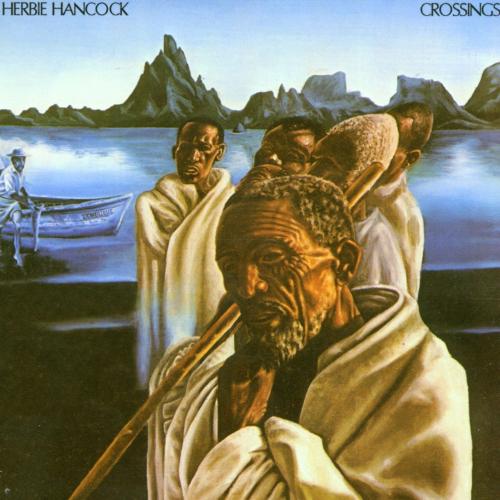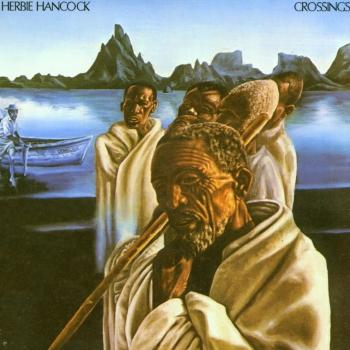
Crossings Herbie Hancock
Album Info
Album Veröffentlichung:
1972
HRA-Veröffentlichung:
19.01.2017
Das Album enthält Albumcover
Entschuldigen Sie bitte!
Sehr geehrter HIGHRESAUDIO Besucher,
leider kann das Album zurzeit aufgrund von Länder- und Lizenzbeschränkungen nicht gekauft werden oder uns liegt der offizielle Veröffentlichungstermin für Ihr Land noch nicht vor. Wir aktualisieren unsere Veröffentlichungstermine ein- bis zweimal die Woche. Bitte schauen Sie ab und zu mal wieder rein.
Wir empfehlen Ihnen das Album auf Ihre Merkliste zu setzen.
Wir bedanken uns für Ihr Verständnis und Ihre Geduld.
Ihr, HIGHRESAUDIO
- 1 Sleeping Giant 24:45
- 2 Quasar 07:22
- 3 Water Torture 13:54
Info zu Crossings
„Crossings“ is the tenth album by jazz pianist Herbie Hancock, released in 1972. It is the second album in his Mwandishi period, which saw him experimenting in electronics. Notably, the album is the band's first to feature their new member - synthesizer player Patrick Gleeson. He was originally only scheduled to "set up his Moog synthesiser for Hancock to play." However, Hancock was so impressed with Gleeson that he "asked Gleason[sic] not only to do the overdubs on the album but join the group."
„With the frenzied knocking of what sounds like a clock shop gone berserk, Crossings takes the Herbie Hancock Sextet even further into the electric avant-garde, creating its own idiom. Crossings songs Now, however, the sextet has become a septet with the addition of Dr. Crossings album for sale Patrick Gleeson on Moog synthesizer, whose electronic decorations, pitchless and not, give the band an even spacier edge. Again, there are only three tracks -- the centerpiece being Hancock's multi-faceted, open-structured suite in five parts called "Sleeping Giant." Nearly 25 minutes long yet amazingly cohesive, "Sleeping Giant" gathers a lot of its strength from a series of funky grooves -- the most potent of which explodes at the tail-end of Part Two -- and Hancock's on-edge Fender Rhodes electric piano solos anticipate his funk adventures later in the '70s. Bennie Maupin's "Quasar" pushes the session into extraterrestrial territory, dominated by Gleeson's wild Moog effects and trumpeter Eddie Henderson's patented fluttering air trumpet. Even stranger is Maupin's "Water Torture," which saunters along freely with splashes of color from Hancock's spooky Mellotron and fuzz-wah-pedaled Fender Rhodes piano, Gleeson's electronics, and a quintet of voices. Still a challenging sonic experience, this music (which can be heard on Warners' Mwandishi two-CD set) has yet to find its audience, though the electronica-minded youth ought to find it dazzling.“ (Richard S. Ginell, AMG)
Herbie Hancock, acoustic piano, electric piano, mellotron, percussion
Eddie Henderson, trumpet, flugelhorn, percussion
Billy Hart, drums, percussion
Julian Priester, bass, tenor and alto trombones; percussion
Buster Williams, electric bass, string bass, percussion
Bennie Maupin, soprano saxophone, alto flute, bass clarinet, piccolo, percussion
Additional musicians:
Patrick Gleeson, Moog synthesizer
Victor Pontoja, congas
Candy Love, vocals
Sandra Stevens, vocals
Della Horne, vocals
Victoria Domagalski, vocals
Scott Breach, vocals
Recorded at Pacific Recording Studios, San Mateo
Engineered by Fred Catero, Patrick Gleeson
Moog and mellotron recorded at Different Fur Trading Company, San Francisco
Produced by David Rubinson
Digitally remastered
Herbie Hancock
Herbie Hancock’s 40-year career as a recording artist is graced by a series of astonishing musical landmarks. Few other musicians of the 20th century have exhibited the wide range of interests and mastery of various genres that this jazz legend has brought to his remarkable body of work. Nonetheless, at the age of 58, Hancock still expresses the kinds of irrepressible curiosity and restless creativity that keep him pushing at the boundaries of modern music.
"At this point in my career," Hancock says, "I’m much more interested in projects that have the potential to be events, not just records. I want to do something broad-based that has the potential to reach into the life of people in more ways than just their ears." The wedding of that ambitious artistic vision to his extraordinary musical versatility put Hancock in the perfect position to approach his new Verve recording, Gershwin's World, a far-reaching tribute to the life and times of the great composer who did so much to popularize the jazz and blues idioms.
"I have always loved Gershwin’s music," Hancock says. "I want to give respect and tribute to all of George Gershwin’s musical origins. The particular genres that Gershwin chose — classical music, jazz, and pop — are ones that I’ve explored, too." Featuring performances by vocal superstars Stevie Wonder, Joni Mitchell, and Kathleen Battle, and the instrumental contributions of the Orpheus Chamber Orchestra, pianist Chick Corea, saxophonists Wayne Shorter, James Carter, and Kenny Garrett, trumpeter Eddie Henderson, and bassist Ira Coleman, Gershwin’s World finds Hancock applying his unique piano genius not only to classic songs by Gershwin, but to pieces by contemporaries closely associated with Gershwin — stride piano master James P. Johnson, blues popularizer W. C. Handy, classical composer Maurice Ravel, and jazz giant Duke Ellington.
Hancock probes the essence of Gershwin’s muse in exciting new contexts, from the opening "Overture", with its African drum extrapolation of "Fascinating Rhythm", through the final, heartfelt solo treatment of "Embraceable You". But he doesn’t stop with Gershwin. The piano duet performance with Corea on Johnson’s "Blueberry Rhyme", the powerful Hancock and Stevie Wonder interpretation of Handy’s "St. Louis Blues", the sumptuous, orchestra-accompanied improvisation on Ravel’s Concerto for Piano in G, and the rousing version of Ellington’s "Cotton Tail", with Shorter soloing on tenor, open new windows on the world from which Gershwin emerged and the world he himself influenced. The African-American blues tradition, the musical ferment in Harlem, and French impressionism all inspired Gershwin. In turn, his "I Got Rhythm" became the basis for countless later jazz compositions, including "Cotton Tail".
The concept for Gershwin’s World was presented to Hancock by Robert Sadin, who produced album. "Herbie Hancock and I discussed this project for more than a year before we started recording," Sadin explains. "We both felt that to celebrate Gershwin, we wanted to honor his largeness of spirit, the musical and personal generosity which was so characteristic of the man. Also, in searching to penetrate the spirit of his music we wanted to create an album which had elements of jazz, classical music, African music, and some flavors which we couldn’t necessarily categorize at all. . . . We wanted to bring out the melodic beauty and rhythmic vitality of Gershwin, but even more, we wanted our work to reflect his searching, adventurous spirit."
That Hancock should devote such energy and commitment to such Gershwin material as "It Ain’t Necessarily So", "The Man I Love", "Summertime", and "Prelude in C# minor", as well as the complementary pieces from other composers, is another example of his lifelong quest for new ways to express his own profound creativity and adventurous spirit. Gershwin’s World comes from the same man who gave us his stunning 1963 debut as a leader, Takin’ Off, the 1973 platinum-selling jazz-rock milestone Headhunters, the unprecedented Grammy®-winning MTV dance hit "Rockit", the 1986 Academy Award-winning score to the film Round Midnight, and the Grammy®-winning 1996 Verve debut The New Standard.
Born in Chicago in 1940, Hancock was classically trained as a youth, and performed Mozart with symphony orchestras as a teen. His apprenticeship in jazz took full swing playing with trumpeter Donald Byrd, saxophone giants Coleman Hawkins, Phil Woods, and Oliver Nelson. After signing with Blue Note Records and scoring his first Top Ten hit with "Watermelon Man", Hancock was invited by Miles Davis to join his quintet, with Wayne Shorter, Ron Carter, and Tony Williams, that would become one of the most influential jazz ensembles of the modern era.
Before and after his tenure with Miles in the mid-1960s, Hancock recorded his own timeless albums, including Maiden Voyage and Speak Like a Child. He also ventured into scoring for films (Michelangelo Antonioni’s 1966 Blow Up) and television (Bill Cosby’s Hey, Hey, Hey, It’s Fat Albert). After leaving the Davis Quintet in 1968, the pianist’s rhythmic innovations exploded into the jazz and funk inventions of his Headhunters band (with Benny Maupin, Harvey Mason, Paul Jackson, and Bill Summers), and such albums as Thrust, Sextant, and Feets Don’t Fail Me Now.
Although much of Hancock’s notoriety and popularity since the 1970s has been based on his electronic dance-beat experiments, such as the 1983 platinum Future Shock album and the hip-hop-inspired Dis Is da Drum CD for Mercury Records in 1994, he has never been far removed from his acoustic roots. In 1976, he reunited with Shorter, Carter, and Williams in V.S.O.P. quintet, featuring Freddie Hubbard on trumpet. (The 1983 edition of V.S.O.P. included an up-and-coming Wynton Marsalis.) After his success with his original score to Bertrand Tavernier’s Round Midnight, Hancock continued to compose for films, including Colors, Jo Jo Dancer, Your Life is Calling, and Harlem Nights.
In the 1990s, Hancock has remained active in both the electronic pop and acoustic jazz worlds. In 1997, he followed up The New Standard with 1+1, a stunning duet recording of improvisations with Hancock on acoustic piano and Wayne Shorter on soprano sax; and in 1998, he participated in the Headhunters reunion recording, Return of the Headhunters, which became the first release on the newly formed Hancock Records.
Even while achieving unparalleled artistic and commercial triumphs, garnering six Grammys®, an Oscar, and countless music magazine poll awards, Hancock has devoted himself to numerous educational and philanthropic endeavors. In the early 1980s, he hosted the innovative PBS music series Rock School, and from 1989 to 1991, he hosted the Showtime cable network series Coast to Coast. He also founded the Rhythm of Life Foundation, dedicated to narrowing the gap between those with and those without access to technology, and to directing technological know-how toward the humanitarian goals of building tolerant, multi-cultural communities, and instilling a sense of courage and creativity in our children. Other responsibilities assumed by Hancock include his seven-year position (since 1991) as Distinguished Artist in Residence at Jazz Aspen Snowmass in Aspen, Colorado, and his role (since 1997) as Artistic Director of the Thelonious Monk Institute of Jazz at the Music Center of Los Angeles County.
It is fitting that at this juncture in his illustrious career, Hancock, an icon of late 20th century modern music, should turn his attention to George Gershwin, who put his indelible stamp on American music before his death in 1937. Just as Gershwin etched an unmistakable identity while shaping the sound of the Broadway show tune, the Hollywood movie score, and the American opera, Hancock has sustained a unique musical voice while influencing the course of mainstream jazz, film soundtracks, and pop-funk fusions in his own time. In this year of Gershwin’s centennial, Gershwin’s World becomes another historic landmark in the rich and uncommonly diverse catalog of another American master, Herbie Hancock.
Dieses Album enthält kein Booklet







































